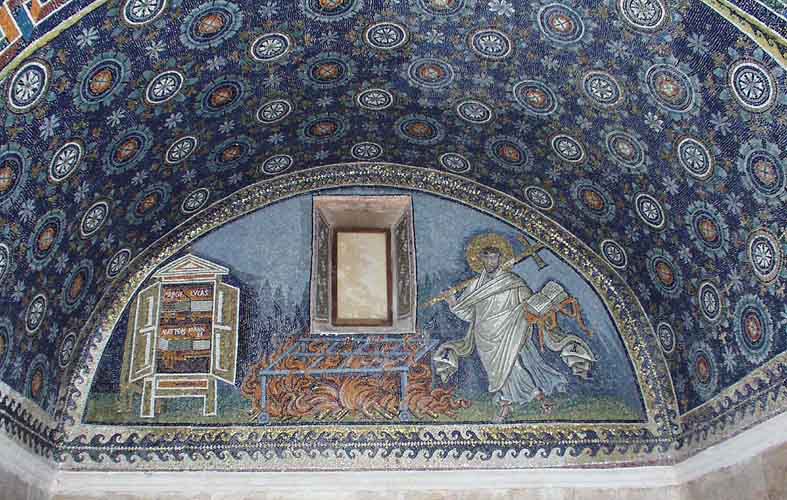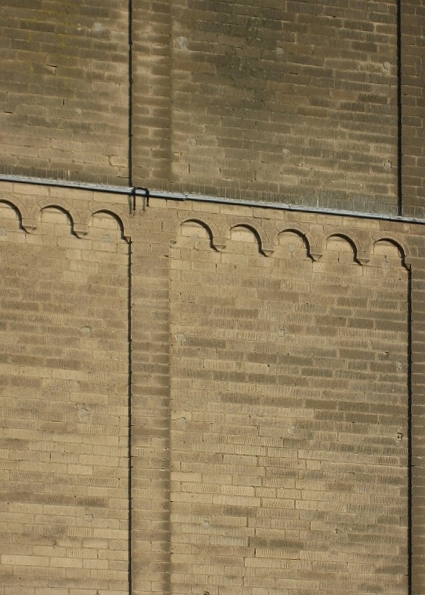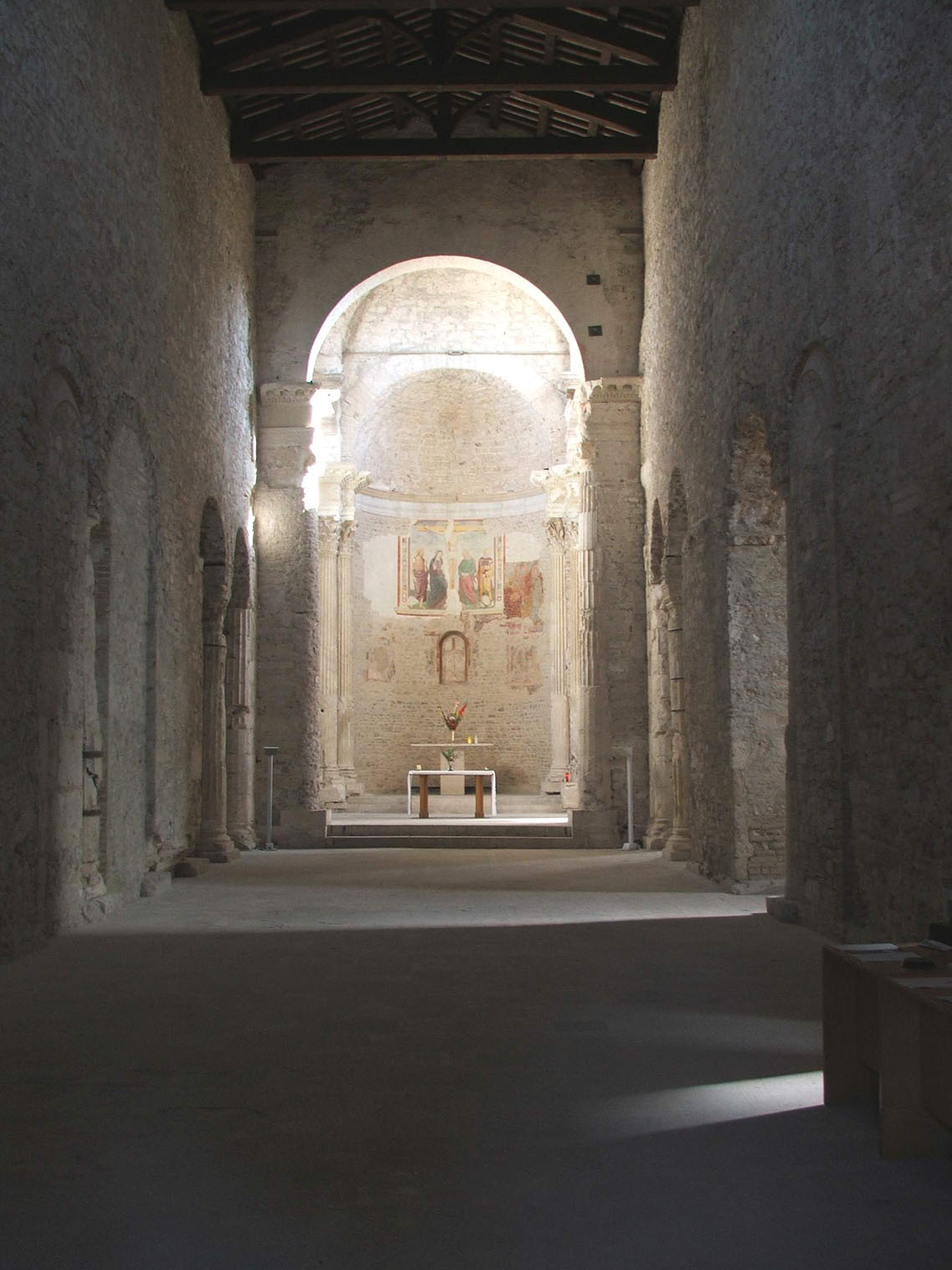|
Lombard Bands
A Lombard band is a decorative blind arcade, usually located on the exterior of building. It was frequently used during the Romanesque and Gothic periods of Western architecture. It resembles a frieze of arches. Lombard bands are believed to have been first used during the First Romanesque period, in the early 11th century. At that time, they were the most common architectural decorative motif for facades in regions such as Lombardy, Aragon and Catalonia. Arches of early Christian buildings of Ravenna, such as the Mausoleum of Galla Placidia, have been suggested as the origin of Lombard bands. See also * Lombard architecture * Lesene (low-relief pillars), another Lombardic element Similar-looking structures: * Corbels * Jettying Jettying (jetty, jutty, from Old French ''getee, jette'') is a building technique used in medieval timber framing, timber-frame buildings in which an upper floor projects beyond the dimensions of the floor below. This has the advantage of incr ... [...More Info...] [...Related Items...] OR: [Wikipedia] [Google] [Baidu] |
Mausoleum Of Galla Placidia
The Mausoleum of Galla Placidia is a Late Antique Roman building in Ravenna, Italy, built between 425 and 450. It was added to the World Heritage List together with seven other structures in Ravenna in 1996. Despite its common name, the empress Galla Placidia (d. 450) was not buried in the building, a misconception dating from the thirteenth century; she died in Rome and was buried there, probably alongside Honorius in the Mausoleum of Honorius at Old Saint Peter's Basilica. History The "mausoleum" of Galla Placidia, built 425–450, is a cruciform chapel or oratory that originally adjoined the narthex of the Church of the Holy Cross (''Santa Croce'') in Ravenna, which was built in 417 as the church for the imperial palace. It was probably dedicated to Saint Lawrence. Aelia Galla Placidia, the likely patron of the building's construction, was the daughter of Theodosius I and Galla, the daughter of Valentinian I. Raised by Serena, wife of Stilicho, she was made '' nobilissi ... [...More Info...] [...Related Items...] OR: [Wikipedia] [Google] [Baidu] |
Ornaments (architecture)
An ornament is something used for decoration. Ornament may also refer to: Decoration *Ornament (art), any purely decorative element in architecture and the decorative arts *Ornamental turning *Biological ornament, a characteristic of animals that appear to serve only a decorative purpose *Bronze and brass ornamental work, decorative work that dates back to antiquity *Christmas ornament, a decoration used to festoon a Christmas tree *Dingbat, decorations in typography *Garden ornament, a decoration in a garden, landscape, or park *Hood ornament, a decoration on the hood of an automobile *Lawn ornament, a decoration in a grassy area *Ornamental plant, a decorative plant *Peak ornament, a decoration under the peak of the eaves of a gabled building Music *Ornament (music), a flourish that serves to decorate music *Ornament, a Russian band, forerunner to the band Kukuruza Other uses *Ornament (football), the football team from Hong Kong *Ornaments Rubric, a prayer of the Church of ... [...More Info...] [...Related Items...] OR: [Wikipedia] [Google] [Baidu] |
Architectural Elements
:''The following Outline (list), outline is an overview and topical guide to architecture:'' Architecture – the process and the product of designing and constructing buildings. Architectural works with a certain indefinable combination of design quality and external circumstances may become cultural symbols and / or be considered works of art. What type of thing is architecture? Architecture can be described as all of the following: * Academic discipline – focused study in one academic field or profession. A discipline incorporates expertise, people, projects, communities, challenges, studies, inquiry, and research areas that are strongly associated with the given discipline. * Buildings – buildings and similar structures, the product of architecture, are referred to as architecture. * One of the arts – as an art form, architecture is an outlet of human expression, that is usually influenced by culture and which in turn helps to change culture. Archit ... [...More Info...] [...Related Items...] OR: [Wikipedia] [Google] [Baidu] |
Jettying
Jettying (jetty, jutty, from Old French ''getee, jette'') is a building technique used in medieval timber framing, timber-frame buildings in which an upper floor projects beyond the dimensions of the floor below. This has the advantage of increasing the available space in the building without obstructing the street. Jettied floors are also termed ''jetties''. In the U.S., the most common surviving colonial version of this is the garrison house. Most jetties are external, but some early medieval houses were built with internal jetties. Structure A jetty is an upper floor that depends on a cantilever system in which a horizontal beam, the jetty bressummer, supports the wall above and projects forward beyond the floor below (a technique also called ''oversailing''). The bressummer (or breastsummer) itself rests on the ends of a row of jetty beams or joists which are supported by jetty plates. Jetty joists in their turn were slotted sideways into the diagonal dragon beams at ... [...More Info...] [...Related Items...] OR: [Wikipedia] [Google] [Baidu] |
Corbel
In architecture, a corbel is a structural piece of stone, wood or metal keyed into and projecting from a wall to carry a wikt:superincumbent, bearing weight, a type of bracket (architecture), bracket. A corbel is a solid piece of material in the wall, whereas a console is a piece applied to the structure. A piece of timber projecting in the same way was called a "tassel" or a "bragger" in England. The technique of corbelling, where rows of corbels deeply keyed inside a wall support a projecting wall or parapet, has been used since Neolithic (New Stone Age) times. It is common in medieval architecture and in the Scottish baronial style as well as in the vocabulary of classical architecture, such as the modillions of a Corinthian order, Corinthian cornice. The corbel arch and corbel vault use the technique systematically to make openings in walls and to form ceilings. These are found in the early architecture of most cultures, from Eurasia to Pre-Columbian architecture. A conso ... [...More Info...] [...Related Items...] OR: [Wikipedia] [Google] [Baidu] |
Lesene
A lesene, also called a pilaster strip, is an architectural term for a narrow, low-relief vertical pillar on a wall. It resembles a pilaster, but does not have a base or capital. It is typical in Lombardic and Rijnlandish architectural building styles. Function Lesenes are used in architecture to vertically divide a façade or other wall surface optically. However, unlike pilasters, lesenes are simpler, having no bases or capitals. Their function is ornamental, not just to decorate the plain surface of a wall but, in the case of corner lesenes (at the edges of a façade), to emphasise the edges of a building. Gallery File:Lisene2.jpg, Lesenes and Lombard band (arches) on a chapel File:Lisene-Ravenna.jpg, Lesenes forming blind arcades, Mausoleum of Galla Placidia, Ravenna (); dentils under the eaves. File:Gernrode-Lisene.jpg, Lesene on the staircase tower, Gernrode collegiate church (pre-1000) File:Maria Laach.jpg, Lesenes on the Maria Laach Abbey (1156) File:Saxon tower - ... [...More Info...] [...Related Items...] OR: [Wikipedia] [Google] [Baidu] |
Lombard Architecture
Lombard architecture refers to the architecture of the Kingdom of the Lombards, which lasted from 568 to 774 (with residual permanence in southern Italy until the 10th–11th centuries) and which was commissioned by Lombard kings and dukes. The architectural works of the Lombards in northern Italy (Langobardia Major) have been mostly lost due to later renovations or reconstructions, the few exceptions including the Oratoria Di Santa Maria, Tempietto longobardo at Cividale del Friuli or the Church of Santa Maria foris portas at Castelseprio (archaeological park), Castelseprio. More examples have instead survived in southern Italy (Langobardia Minor), especially in what was the Duchy of Benevento: they include the city's walls, the church of Santa Sofia, Benevento, Santa Sofia and the Rocca dei Rettori, one of the few surviving Lombard military structures, as well as other minor sites near Benevento and in the former duchy of Spoleto. The main surviving examples of Lombard architectu ... [...More Info...] [...Related Items...] OR: [Wikipedia] [Google] [Baidu] |
Catalonia
Catalonia is an autonomous community of Spain, designated as a ''nationalities and regions of Spain, nationality'' by its Statute of Autonomy of Catalonia of 2006, Statute of Autonomy. Most of its territory (except the Val d'Aran) is situated on the northeast of the Iberian Peninsula, to the south of the Pyrenees mountain range. Catalonia is administratively divided into four Provinces of Spain, provinces or eight Vegueries of Catalonia, ''vegueries'' (regions), which are in turn divided into 43 Comarques of Catalonia, ''comarques''. The capital and largest city, Barcelona, is the second-most populous Municipalities in Spain, municipality in Spain and the fifth-most populous List of metropolitan areas in Europe, urban area in the European Union. > > > ''Catalonia'' theoretically derived. During the Middle Ages, Byzantine Empire, Byzantine chroniclers claimed that ''Catalania'' derives from the local medley of Goths with Alans, initially constituting a ''Goth-Alania''. Othe ... [...More Info...] [...Related Items...] OR: [Wikipedia] [Google] [Baidu] |
Blind Arcade
Blind often refers to: * The state of blindness, being unable to see * A window blind, a covering for a window Blind may also refer to: Arts, entertainment, and media Films * ''Blind'' (1987 film), a documentary by Frederick Wiseman about the Alabama Institute for Deaf and Blind * ''Blind'' (2007 film), a Dutch drama by Tamar van den Dop * ''Blind'' (2011 film), a South Korean crime thriller * ''Blind'' (2014 film), a Norwegian drama * ''Blind'' (2016 film), an American drama * ''Blind'' (2019 film), an American horror film * ''Blind'' (2023 film), an Indian crime thriller, based on 2011 South Korean film of the same name * ''The Blind'' (film), a 2023 American biographical film about Phil Robertson, directed by Andrew Hyatt Music * Blind (band), Estonian rock group founded in 1994, originally Totally Blind Drunk Drivers * Blind (band), Australian Christian rock group founded in 1999 * Blind (rapper), Italian rapper Albums and EPs * ''Blind'' (Corrosion of Con ... [...More Info...] [...Related Items...] OR: [Wikipedia] [Google] [Baidu] |
Aragon
Aragon ( , ; Spanish and ; ) is an autonomous communities of Spain, autonomous community in Spain, coextensive with the medieval Kingdom of Aragon. In northeastern Spain, the Aragonese autonomous community comprises three provinces of Spain, provinces (from north to south): Province of Huesca, Huesca, Province of Zaragoza, Zaragoza, and Province of Teruel, Teruel. Its capital is Zaragoza. The current Statute of Autonomy declares Aragon a ''nationalities and regions of Spain, historic nationality'' of Spain. Covering an area of , the region's terrain ranges diversely from permanent glaciers to verdant valleys, rich pasture lands and orchards, through to the arid steppes of the central lowlands. Aragon is home to many rivers—most notably, the river Ebro, Spain's largest river in volume, which runs west–east across the entire region through the province of Zaragoza. It is also home to the Pyrenees#Highest summits, highest mountains of the Pyrenees. , the population of Arago ... [...More Info...] [...Related Items...] OR: [Wikipedia] [Google] [Baidu] |
Lombardy
The Lombardy Region (; ) is an administrative regions of Italy, region of Italy that covers ; it is located in northern Italy and has a population of about 10 million people, constituting more than one-sixth of Italy's population. Lombardy is located between the Alps mountain range and tributaries of the river Po (river), Po, and includes Milan, its capital, the largest metropolitan area in the country, and among the largest in the EU. Its territory is divided into 1,502 ''comuni'' (the region with the largest number of ''comuni'' in the entire national territory), distributed among twelve administrative subdivisions (eleven Provinces of Italy, provinces plus the Metropolitan City of Milan). The region ranks first in Italy in terms of population, population density, and number of local authorities, while it is fourth in terms of surface area, after Sicily, Piedmont, and Sardinia. It is the second-most populous Region (Europe), region of the European Union (EU), and the List of ... [...More Info...] [...Related Items...] OR: [Wikipedia] [Google] [Baidu] |






